Strategies of Canadian Tourism Agencies to Curb Avian Flu Outbreaks
VerifiedAdded on 2020/04/01
|10
|3854
|43
Report
AI Summary
This report examines the measures implemented by Canadian tourism agencies to mitigate the impact of avian flu outbreaks. The paper begins by outlining the context of avian flu as a global concern, emphasizing its potential effects on public health, the economy, and the tourism sector. It highlights the need for proactive measures, referencing past outbreaks and their consequences. The report details specific strategies employed by Canadian tourism agencies, including communication with the public and tourists to disseminate accurate and timely information, implementation of biosecurity protocols on farms to prevent disease spread, and influenza surveillance to monitor and respond to outbreaks. The paper also discusses measures such as travel restrictions, temperature screening, and vaccination programs to protect both residents and visitors. It also provides insights into the importance of international collaboration, transparent information sharing, and the role of the government in compensating farmers for losses. Overall, the report provides a comprehensive overview of the Canadian tourism industry's approach to managing the risks associated with avian flu and its impact on the tourism sector and the economy.
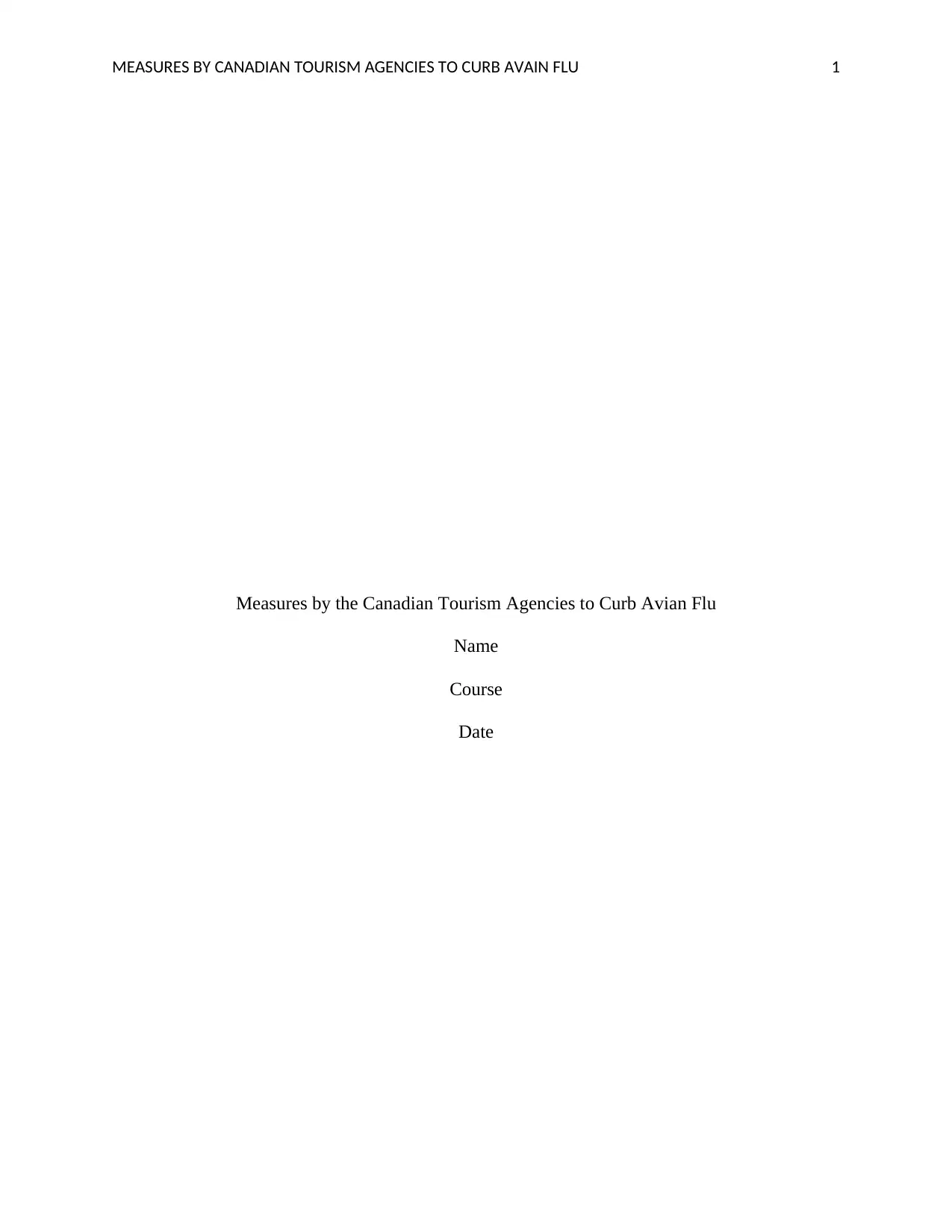
MEASURES BY CANADIAN TOURISM AGENCIES TO CURB AVAIN FLU 1
Measures by the Canadian Tourism Agencies to Curb Avian Flu
Name
Course
Date
Measures by the Canadian Tourism Agencies to Curb Avian Flu
Name
Course
Date
Paraphrase This Document
Need a fresh take? Get an instant paraphrase of this document with our AI Paraphraser
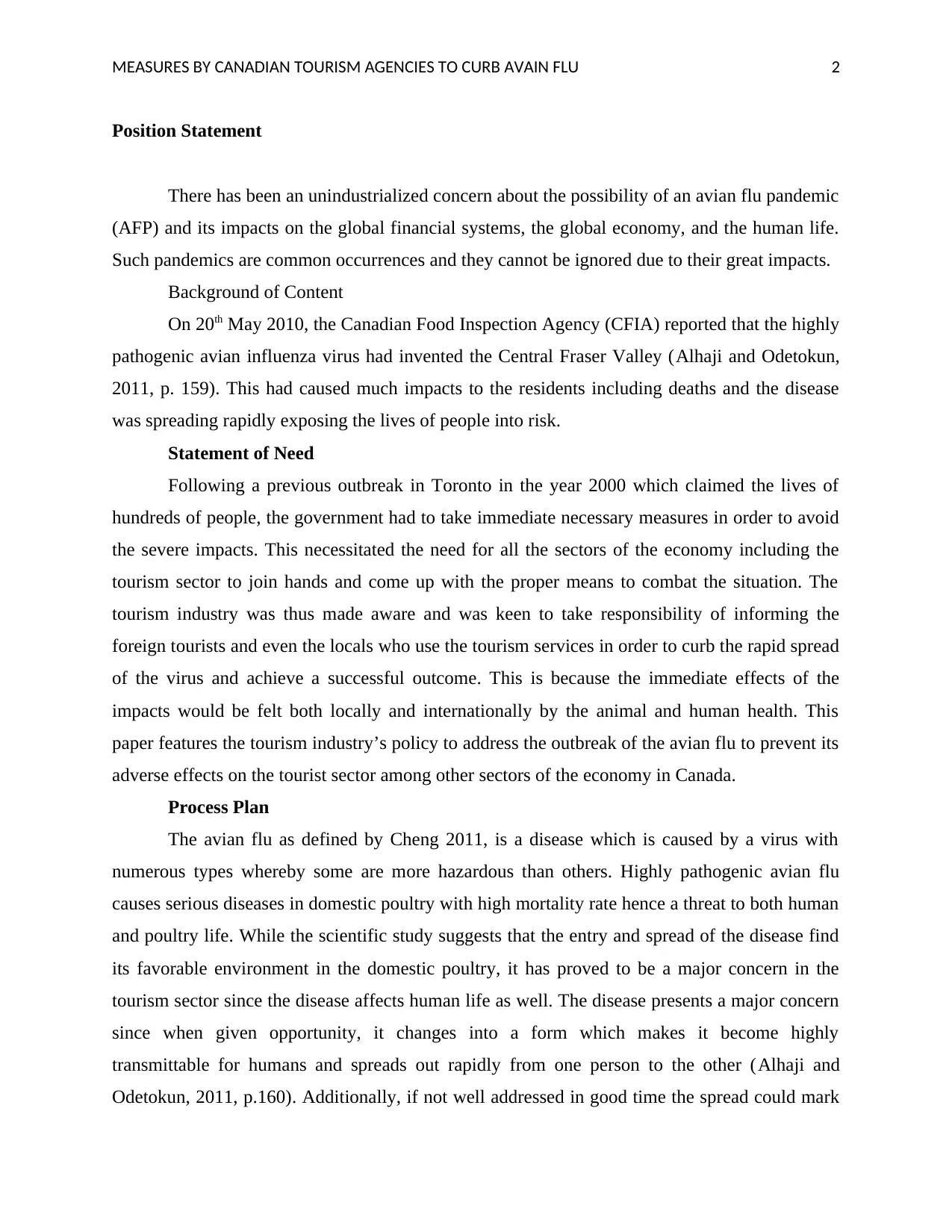
MEASURES BY CANADIAN TOURISM AGENCIES TO CURB AVAIN FLU 2
Position Statement
There has been an unindustrialized concern about the possibility of an avian flu pandemic
(AFP) and its impacts on the global financial systems, the global economy, and the human life.
Such pandemics are common occurrences and they cannot be ignored due to their great impacts.
Background of Content
On 20th May 2010, the Canadian Food Inspection Agency (CFIA) reported that the highly
pathogenic avian influenza virus had invented the Central Fraser Valley (Alhaji and Odetokun,
2011, p. 159). This had caused much impacts to the residents including deaths and the disease
was spreading rapidly exposing the lives of people into risk.
Statement of Need
Following a previous outbreak in Toronto in the year 2000 which claimed the lives of
hundreds of people, the government had to take immediate necessary measures in order to avoid
the severe impacts. This necessitated the need for all the sectors of the economy including the
tourism sector to join hands and come up with the proper means to combat the situation. The
tourism industry was thus made aware and was keen to take responsibility of informing the
foreign tourists and even the locals who use the tourism services in order to curb the rapid spread
of the virus and achieve a successful outcome. This is because the immediate effects of the
impacts would be felt both locally and internationally by the animal and human health. This
paper features the tourism industry’s policy to address the outbreak of the avian flu to prevent its
adverse effects on the tourist sector among other sectors of the economy in Canada.
Process Plan
The avian flu as defined by Cheng 2011, is a disease which is caused by a virus with
numerous types whereby some are more hazardous than others. Highly pathogenic avian flu
causes serious diseases in domestic poultry with high mortality rate hence a threat to both human
and poultry life. While the scientific study suggests that the entry and spread of the disease find
its favorable environment in the domestic poultry, it has proved to be a major concern in the
tourism sector since the disease affects human life as well. The disease presents a major concern
since when given opportunity, it changes into a form which makes it become highly
transmittable for humans and spreads out rapidly from one person to the other (Alhaji and
Odetokun, 2011, p.160). Additionally, if not well addressed in good time the spread could mark
Position Statement
There has been an unindustrialized concern about the possibility of an avian flu pandemic
(AFP) and its impacts on the global financial systems, the global economy, and the human life.
Such pandemics are common occurrences and they cannot be ignored due to their great impacts.
Background of Content
On 20th May 2010, the Canadian Food Inspection Agency (CFIA) reported that the highly
pathogenic avian influenza virus had invented the Central Fraser Valley (Alhaji and Odetokun,
2011, p. 159). This had caused much impacts to the residents including deaths and the disease
was spreading rapidly exposing the lives of people into risk.
Statement of Need
Following a previous outbreak in Toronto in the year 2000 which claimed the lives of
hundreds of people, the government had to take immediate necessary measures in order to avoid
the severe impacts. This necessitated the need for all the sectors of the economy including the
tourism sector to join hands and come up with the proper means to combat the situation. The
tourism industry was thus made aware and was keen to take responsibility of informing the
foreign tourists and even the locals who use the tourism services in order to curb the rapid spread
of the virus and achieve a successful outcome. This is because the immediate effects of the
impacts would be felt both locally and internationally by the animal and human health. This
paper features the tourism industry’s policy to address the outbreak of the avian flu to prevent its
adverse effects on the tourist sector among other sectors of the economy in Canada.
Process Plan
The avian flu as defined by Cheng 2011, is a disease which is caused by a virus with
numerous types whereby some are more hazardous than others. Highly pathogenic avian flu
causes serious diseases in domestic poultry with high mortality rate hence a threat to both human
and poultry life. While the scientific study suggests that the entry and spread of the disease find
its favorable environment in the domestic poultry, it has proved to be a major concern in the
tourism sector since the disease affects human life as well. The disease presents a major concern
since when given opportunity, it changes into a form which makes it become highly
transmittable for humans and spreads out rapidly from one person to the other (Alhaji and
Odetokun, 2011, p.160). Additionally, if not well addressed in good time the spread could mark
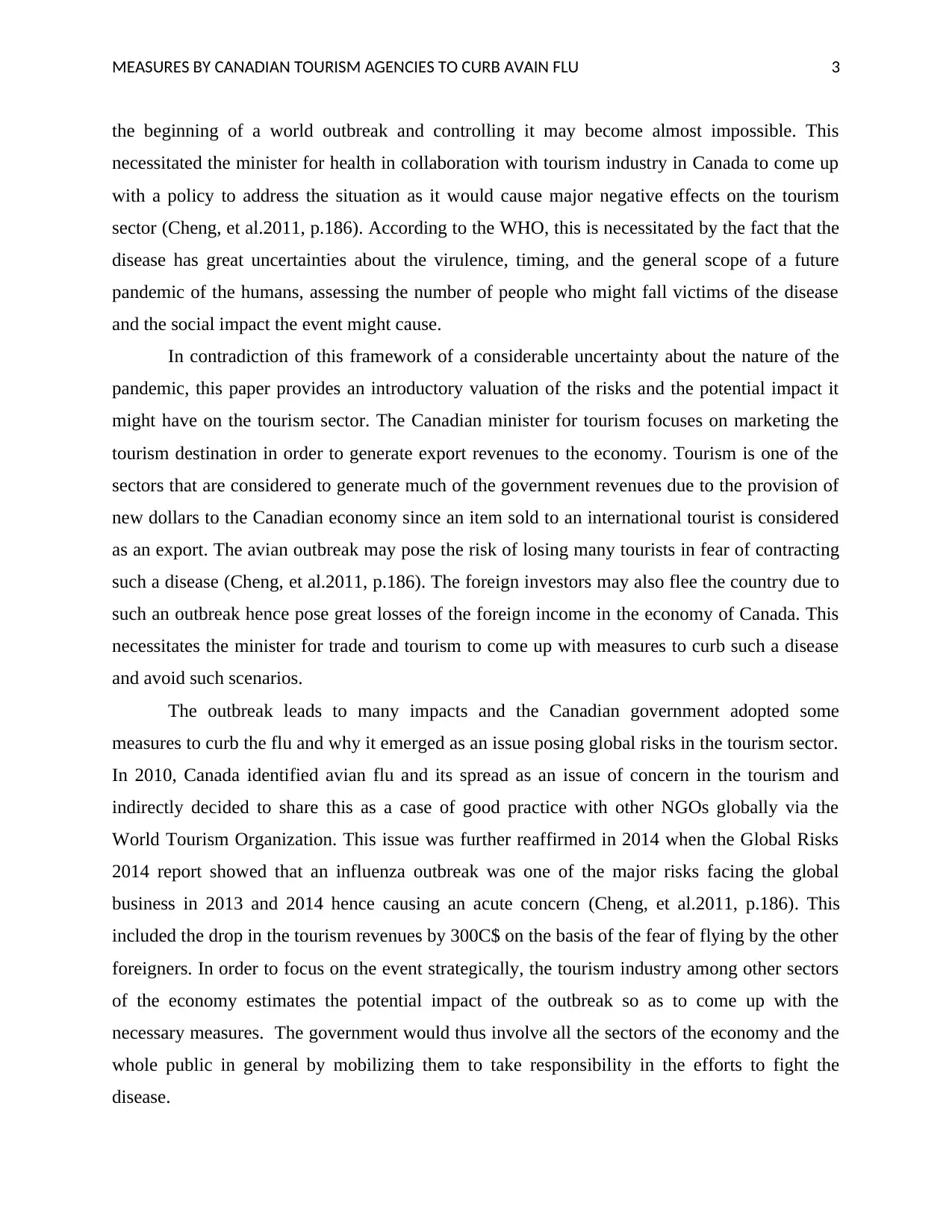
MEASURES BY CANADIAN TOURISM AGENCIES TO CURB AVAIN FLU 3
the beginning of a world outbreak and controlling it may become almost impossible. This
necessitated the minister for health in collaboration with tourism industry in Canada to come up
with a policy to address the situation as it would cause major negative effects on the tourism
sector (Cheng, et al.2011, p.186). According to the WHO, this is necessitated by the fact that the
disease has great uncertainties about the virulence, timing, and the general scope of a future
pandemic of the humans, assessing the number of people who might fall victims of the disease
and the social impact the event might cause.
In contradiction of this framework of a considerable uncertainty about the nature of the
pandemic, this paper provides an introductory valuation of the risks and the potential impact it
might have on the tourism sector. The Canadian minister for tourism focuses on marketing the
tourism destination in order to generate export revenues to the economy. Tourism is one of the
sectors that are considered to generate much of the government revenues due to the provision of
new dollars to the Canadian economy since an item sold to an international tourist is considered
as an export. The avian outbreak may pose the risk of losing many tourists in fear of contracting
such a disease (Cheng, et al.2011, p.186). The foreign investors may also flee the country due to
such an outbreak hence pose great losses of the foreign income in the economy of Canada. This
necessitates the minister for trade and tourism to come up with measures to curb such a disease
and avoid such scenarios.
The outbreak leads to many impacts and the Canadian government adopted some
measures to curb the flu and why it emerged as an issue posing global risks in the tourism sector.
In 2010, Canada identified avian flu and its spread as an issue of concern in the tourism and
indirectly decided to share this as a case of good practice with other NGOs globally via the
World Tourism Organization. This issue was further reaffirmed in 2014 when the Global Risks
2014 report showed that an influenza outbreak was one of the major risks facing the global
business in 2013 and 2014 hence causing an acute concern (Cheng, et al.2011, p.186). This
included the drop in the tourism revenues by 300C$ on the basis of the fear of flying by the other
foreigners. In order to focus on the event strategically, the tourism industry among other sectors
of the economy estimates the potential impact of the outbreak so as to come up with the
necessary measures. The government would thus involve all the sectors of the economy and the
whole public in general by mobilizing them to take responsibility in the efforts to fight the
disease.
the beginning of a world outbreak and controlling it may become almost impossible. This
necessitated the minister for health in collaboration with tourism industry in Canada to come up
with a policy to address the situation as it would cause major negative effects on the tourism
sector (Cheng, et al.2011, p.186). According to the WHO, this is necessitated by the fact that the
disease has great uncertainties about the virulence, timing, and the general scope of a future
pandemic of the humans, assessing the number of people who might fall victims of the disease
and the social impact the event might cause.
In contradiction of this framework of a considerable uncertainty about the nature of the
pandemic, this paper provides an introductory valuation of the risks and the potential impact it
might have on the tourism sector. The Canadian minister for tourism focuses on marketing the
tourism destination in order to generate export revenues to the economy. Tourism is one of the
sectors that are considered to generate much of the government revenues due to the provision of
new dollars to the Canadian economy since an item sold to an international tourist is considered
as an export. The avian outbreak may pose the risk of losing many tourists in fear of contracting
such a disease (Cheng, et al.2011, p.186). The foreign investors may also flee the country due to
such an outbreak hence pose great losses of the foreign income in the economy of Canada. This
necessitates the minister for trade and tourism to come up with measures to curb such a disease
and avoid such scenarios.
The outbreak leads to many impacts and the Canadian government adopted some
measures to curb the flu and why it emerged as an issue posing global risks in the tourism sector.
In 2010, Canada identified avian flu and its spread as an issue of concern in the tourism and
indirectly decided to share this as a case of good practice with other NGOs globally via the
World Tourism Organization. This issue was further reaffirmed in 2014 when the Global Risks
2014 report showed that an influenza outbreak was one of the major risks facing the global
business in 2013 and 2014 hence causing an acute concern (Cheng, et al.2011, p.186). This
included the drop in the tourism revenues by 300C$ on the basis of the fear of flying by the other
foreigners. In order to focus on the event strategically, the tourism industry among other sectors
of the economy estimates the potential impact of the outbreak so as to come up with the
necessary measures. The government would thus involve all the sectors of the economy and the
whole public in general by mobilizing them to take responsibility in the efforts to fight the
disease.
⊘ This is a preview!⊘
Do you want full access?
Subscribe today to unlock all pages.

Trusted by 1+ million students worldwide
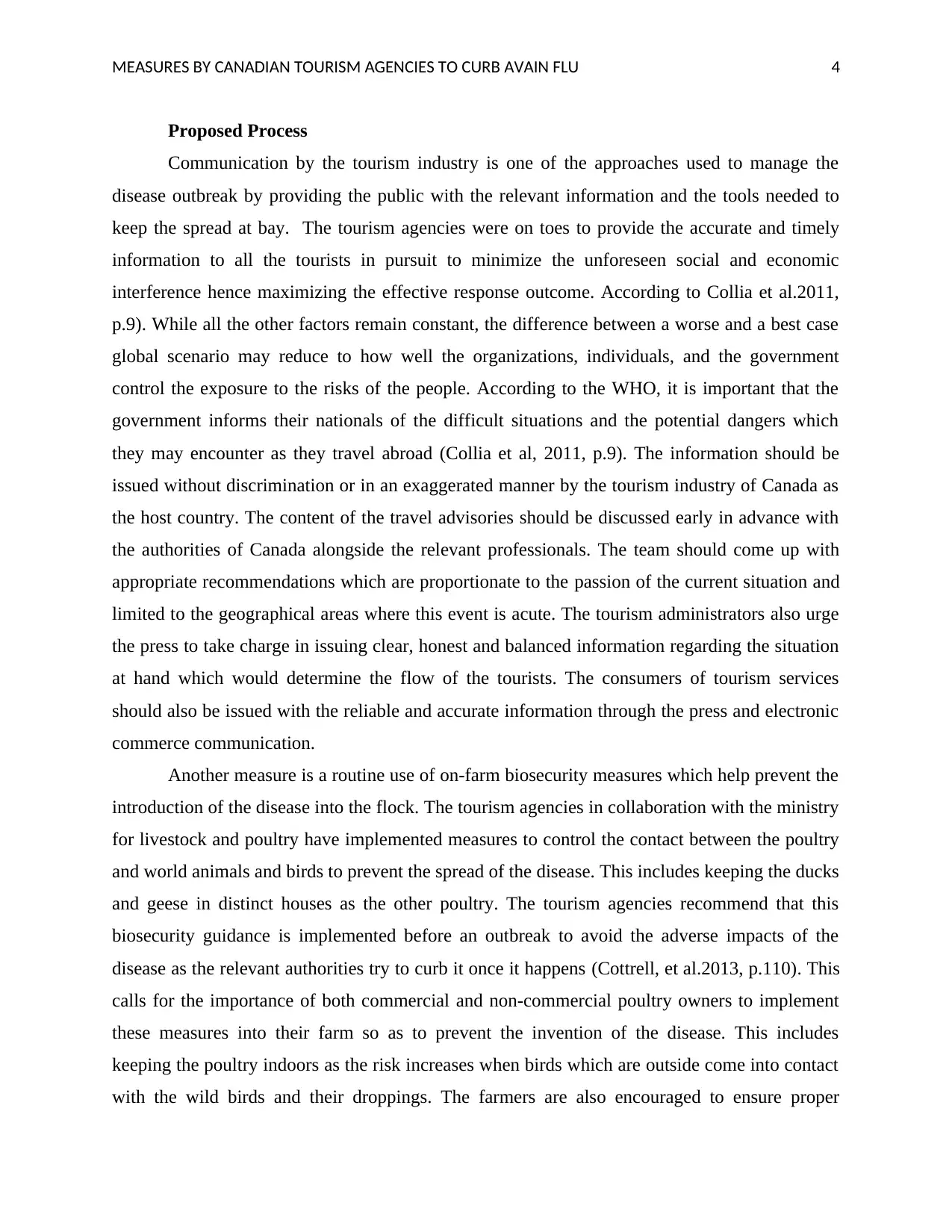
MEASURES BY CANADIAN TOURISM AGENCIES TO CURB AVAIN FLU 4
Proposed Process
Communication by the tourism industry is one of the approaches used to manage the
disease outbreak by providing the public with the relevant information and the tools needed to
keep the spread at bay. The tourism agencies were on toes to provide the accurate and timely
information to all the tourists in pursuit to minimize the unforeseen social and economic
interference hence maximizing the effective response outcome. According to Collia et al.2011,
p.9). While all the other factors remain constant, the difference between a worse and a best case
global scenario may reduce to how well the organizations, individuals, and the government
control the exposure to the risks of the people. According to the WHO, it is important that the
government informs their nationals of the difficult situations and the potential dangers which
they may encounter as they travel abroad (Collia et al, 2011, p.9). The information should be
issued without discrimination or in an exaggerated manner by the tourism industry of Canada as
the host country. The content of the travel advisories should be discussed early in advance with
the authorities of Canada alongside the relevant professionals. The team should come up with
appropriate recommendations which are proportionate to the passion of the current situation and
limited to the geographical areas where this event is acute. The tourism administrators also urge
the press to take charge in issuing clear, honest and balanced information regarding the situation
at hand which would determine the flow of the tourists. The consumers of tourism services
should also be issued with the reliable and accurate information through the press and electronic
commerce communication.
Another measure is a routine use of on-farm biosecurity measures which help prevent the
introduction of the disease into the flock. The tourism agencies in collaboration with the ministry
for livestock and poultry have implemented measures to control the contact between the poultry
and world animals and birds to prevent the spread of the disease. This includes keeping the ducks
and geese in distinct houses as the other poultry. The tourism agencies recommend that this
biosecurity guidance is implemented before an outbreak to avoid the adverse impacts of the
disease as the relevant authorities try to curb it once it happens (Cottrell, et al.2013, p.110). This
calls for the importance of both commercial and non-commercial poultry owners to implement
these measures into their farm so as to prevent the invention of the disease. This includes
keeping the poultry indoors as the risk increases when birds which are outside come into contact
with the wild birds and their droppings. The farmers are also encouraged to ensure proper
Proposed Process
Communication by the tourism industry is one of the approaches used to manage the
disease outbreak by providing the public with the relevant information and the tools needed to
keep the spread at bay. The tourism agencies were on toes to provide the accurate and timely
information to all the tourists in pursuit to minimize the unforeseen social and economic
interference hence maximizing the effective response outcome. According to Collia et al.2011,
p.9). While all the other factors remain constant, the difference between a worse and a best case
global scenario may reduce to how well the organizations, individuals, and the government
control the exposure to the risks of the people. According to the WHO, it is important that the
government informs their nationals of the difficult situations and the potential dangers which
they may encounter as they travel abroad (Collia et al, 2011, p.9). The information should be
issued without discrimination or in an exaggerated manner by the tourism industry of Canada as
the host country. The content of the travel advisories should be discussed early in advance with
the authorities of Canada alongside the relevant professionals. The team should come up with
appropriate recommendations which are proportionate to the passion of the current situation and
limited to the geographical areas where this event is acute. The tourism administrators also urge
the press to take charge in issuing clear, honest and balanced information regarding the situation
at hand which would determine the flow of the tourists. The consumers of tourism services
should also be issued with the reliable and accurate information through the press and electronic
commerce communication.
Another measure is a routine use of on-farm biosecurity measures which help prevent the
introduction of the disease into the flock. The tourism agencies in collaboration with the ministry
for livestock and poultry have implemented measures to control the contact between the poultry
and world animals and birds to prevent the spread of the disease. This includes keeping the ducks
and geese in distinct houses as the other poultry. The tourism agencies recommend that this
biosecurity guidance is implemented before an outbreak to avoid the adverse impacts of the
disease as the relevant authorities try to curb it once it happens (Cottrell, et al.2013, p.110). This
calls for the importance of both commercial and non-commercial poultry owners to implement
these measures into their farm so as to prevent the invention of the disease. This includes
keeping the poultry indoors as the risk increases when birds which are outside come into contact
with the wild birds and their droppings. The farmers are also encouraged to ensure proper
Paraphrase This Document
Need a fresh take? Get an instant paraphrase of this document with our AI Paraphraser
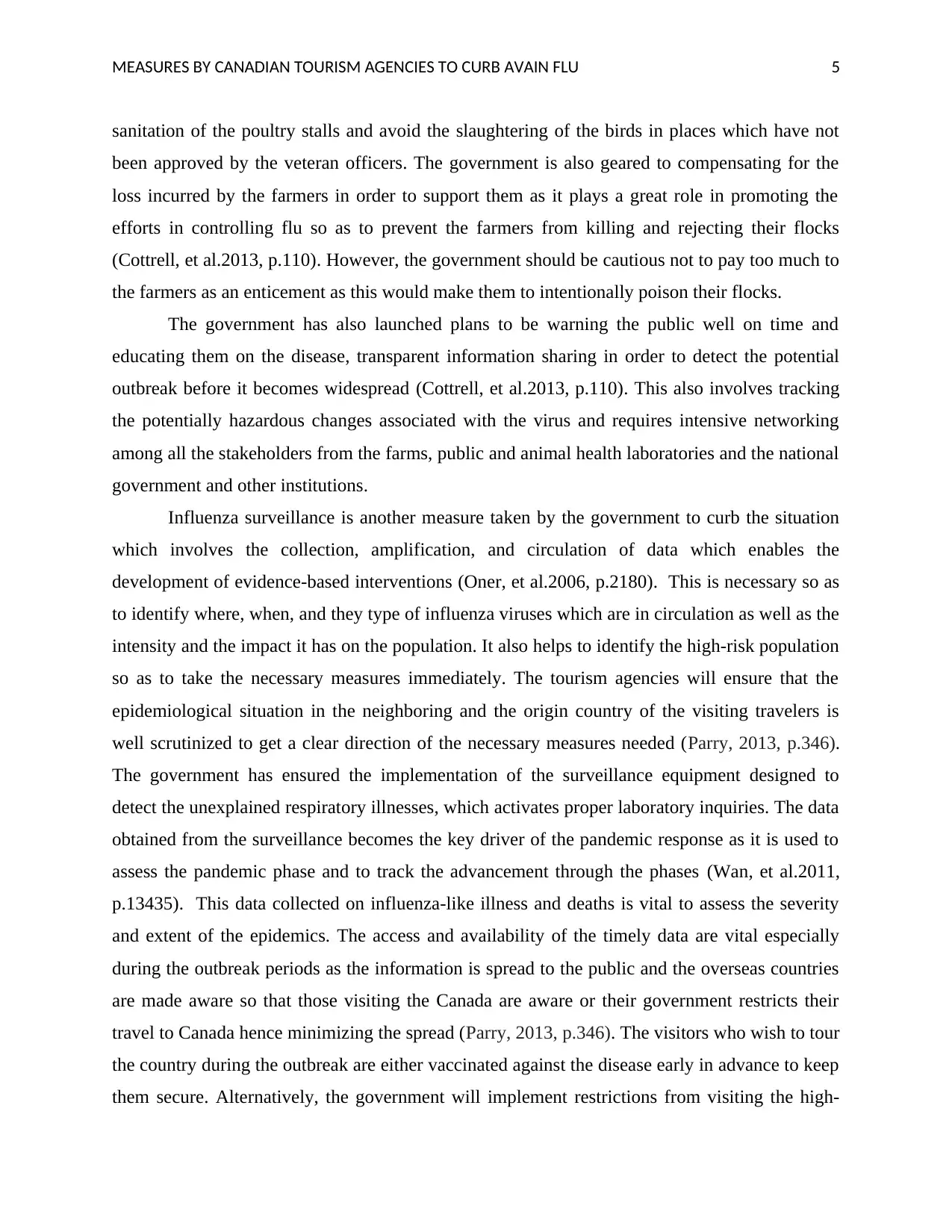
MEASURES BY CANADIAN TOURISM AGENCIES TO CURB AVAIN FLU 5
sanitation of the poultry stalls and avoid the slaughtering of the birds in places which have not
been approved by the veteran officers. The government is also geared to compensating for the
loss incurred by the farmers in order to support them as it plays a great role in promoting the
efforts in controlling flu so as to prevent the farmers from killing and rejecting their flocks
(Cottrell, et al.2013, p.110). However, the government should be cautious not to pay too much to
the farmers as an enticement as this would make them to intentionally poison their flocks.
The government has also launched plans to be warning the public well on time and
educating them on the disease, transparent information sharing in order to detect the potential
outbreak before it becomes widespread (Cottrell, et al.2013, p.110). This also involves tracking
the potentially hazardous changes associated with the virus and requires intensive networking
among all the stakeholders from the farms, public and animal health laboratories and the national
government and other institutions.
Influenza surveillance is another measure taken by the government to curb the situation
which involves the collection, amplification, and circulation of data which enables the
development of evidence-based interventions (Oner, et al.2006, p.2180). This is necessary so as
to identify where, when, and they type of influenza viruses which are in circulation as well as the
intensity and the impact it has on the population. It also helps to identify the high-risk population
so as to take the necessary measures immediately. The tourism agencies will ensure that the
epidemiological situation in the neighboring and the origin country of the visiting travelers is
well scrutinized to get a clear direction of the necessary measures needed (Parry, 2013, p.346).
The government has ensured the implementation of the surveillance equipment designed to
detect the unexplained respiratory illnesses, which activates proper laboratory inquiries. The data
obtained from the surveillance becomes the key driver of the pandemic response as it is used to
assess the pandemic phase and to track the advancement through the phases (Wan, et al.2011,
p.13435). This data collected on influenza-like illness and deaths is vital to assess the severity
and extent of the epidemics. The access and availability of the timely data are vital especially
during the outbreak periods as the information is spread to the public and the overseas countries
are made aware so that those visiting the Canada are aware or their government restricts their
travel to Canada hence minimizing the spread (Parry, 2013, p.346). The visitors who wish to tour
the country during the outbreak are either vaccinated against the disease early in advance to keep
them secure. Alternatively, the government will implement restrictions from visiting the high-
sanitation of the poultry stalls and avoid the slaughtering of the birds in places which have not
been approved by the veteran officers. The government is also geared to compensating for the
loss incurred by the farmers in order to support them as it plays a great role in promoting the
efforts in controlling flu so as to prevent the farmers from killing and rejecting their flocks
(Cottrell, et al.2013, p.110). However, the government should be cautious not to pay too much to
the farmers as an enticement as this would make them to intentionally poison their flocks.
The government has also launched plans to be warning the public well on time and
educating them on the disease, transparent information sharing in order to detect the potential
outbreak before it becomes widespread (Cottrell, et al.2013, p.110). This also involves tracking
the potentially hazardous changes associated with the virus and requires intensive networking
among all the stakeholders from the farms, public and animal health laboratories and the national
government and other institutions.
Influenza surveillance is another measure taken by the government to curb the situation
which involves the collection, amplification, and circulation of data which enables the
development of evidence-based interventions (Oner, et al.2006, p.2180). This is necessary so as
to identify where, when, and they type of influenza viruses which are in circulation as well as the
intensity and the impact it has on the population. It also helps to identify the high-risk population
so as to take the necessary measures immediately. The tourism agencies will ensure that the
epidemiological situation in the neighboring and the origin country of the visiting travelers is
well scrutinized to get a clear direction of the necessary measures needed (Parry, 2013, p.346).
The government has ensured the implementation of the surveillance equipment designed to
detect the unexplained respiratory illnesses, which activates proper laboratory inquiries. The data
obtained from the surveillance becomes the key driver of the pandemic response as it is used to
assess the pandemic phase and to track the advancement through the phases (Wan, et al.2011,
p.13435). This data collected on influenza-like illness and deaths is vital to assess the severity
and extent of the epidemics. The access and availability of the timely data are vital especially
during the outbreak periods as the information is spread to the public and the overseas countries
are made aware so that those visiting the Canada are aware or their government restricts their
travel to Canada hence minimizing the spread (Parry, 2013, p.346). The visitors who wish to tour
the country during the outbreak are either vaccinated against the disease early in advance to keep
them secure. Alternatively, the government will implement restrictions from visiting the high-
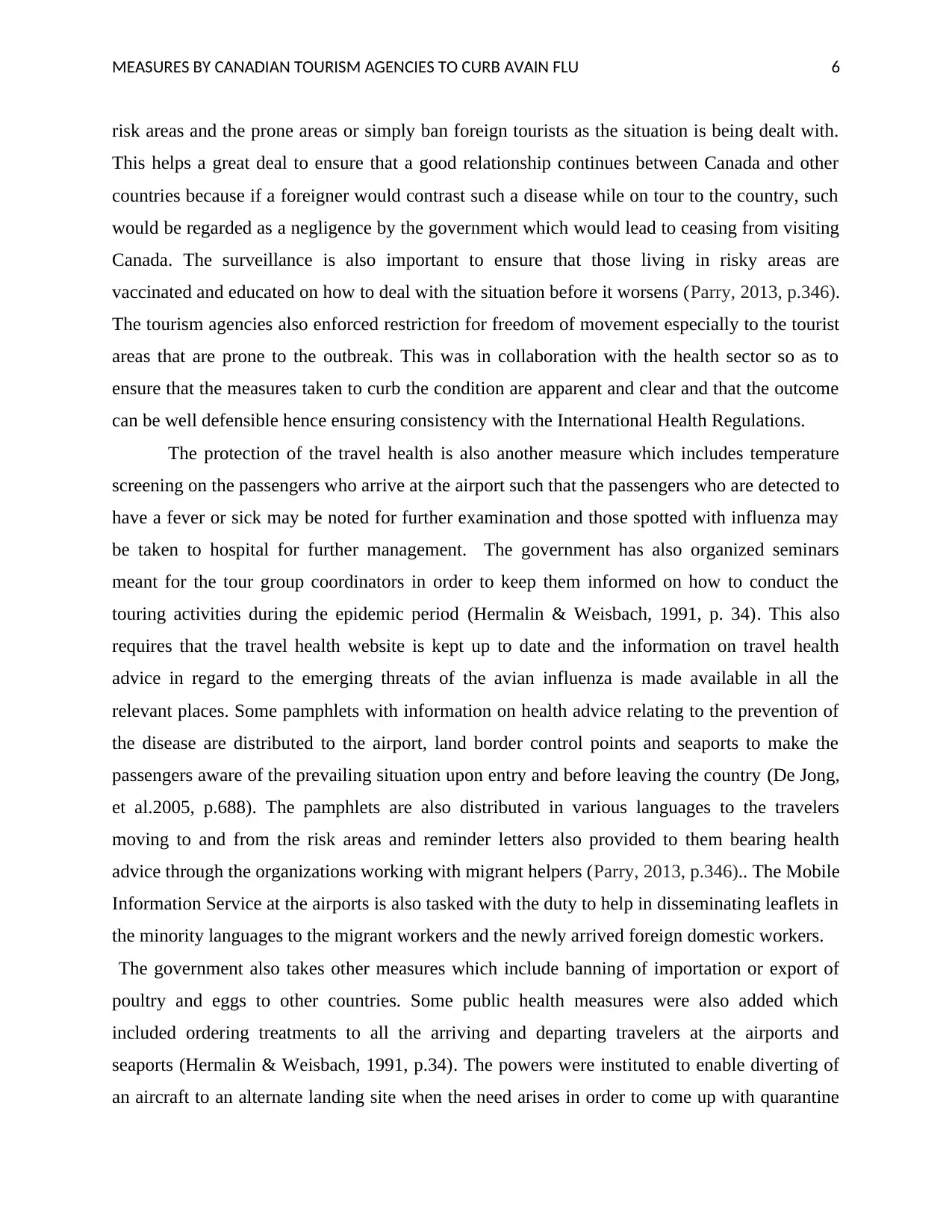
MEASURES BY CANADIAN TOURISM AGENCIES TO CURB AVAIN FLU 6
risk areas and the prone areas or simply ban foreign tourists as the situation is being dealt with.
This helps a great deal to ensure that a good relationship continues between Canada and other
countries because if a foreigner would contrast such a disease while on tour to the country, such
would be regarded as a negligence by the government which would lead to ceasing from visiting
Canada. The surveillance is also important to ensure that those living in risky areas are
vaccinated and educated on how to deal with the situation before it worsens (Parry, 2013, p.346).
The tourism agencies also enforced restriction for freedom of movement especially to the tourist
areas that are prone to the outbreak. This was in collaboration with the health sector so as to
ensure that the measures taken to curb the condition are apparent and clear and that the outcome
can be well defensible hence ensuring consistency with the International Health Regulations.
The protection of the travel health is also another measure which includes temperature
screening on the passengers who arrive at the airport such that the passengers who are detected to
have a fever or sick may be noted for further examination and those spotted with influenza may
be taken to hospital for further management. The government has also organized seminars
meant for the tour group coordinators in order to keep them informed on how to conduct the
touring activities during the epidemic period (Hermalin & Weisbach, 1991, p. 34). This also
requires that the travel health website is kept up to date and the information on travel health
advice in regard to the emerging threats of the avian influenza is made available in all the
relevant places. Some pamphlets with information on health advice relating to the prevention of
the disease are distributed to the airport, land border control points and seaports to make the
passengers aware of the prevailing situation upon entry and before leaving the country (De Jong,
et al.2005, p.688). The pamphlets are also distributed in various languages to the travelers
moving to and from the risk areas and reminder letters also provided to them bearing health
advice through the organizations working with migrant helpers (Parry, 2013, p.346).. The Mobile
Information Service at the airports is also tasked with the duty to help in disseminating leaflets in
the minority languages to the migrant workers and the newly arrived foreign domestic workers.
The government also takes other measures which include banning of importation or export of
poultry and eggs to other countries. Some public health measures were also added which
included ordering treatments to all the arriving and departing travelers at the airports and
seaports (Hermalin & Weisbach, 1991, p.34). The powers were instituted to enable diverting of
an aircraft to an alternate landing site when the need arises in order to come up with quarantine
risk areas and the prone areas or simply ban foreign tourists as the situation is being dealt with.
This helps a great deal to ensure that a good relationship continues between Canada and other
countries because if a foreigner would contrast such a disease while on tour to the country, such
would be regarded as a negligence by the government which would lead to ceasing from visiting
Canada. The surveillance is also important to ensure that those living in risky areas are
vaccinated and educated on how to deal with the situation before it worsens (Parry, 2013, p.346).
The tourism agencies also enforced restriction for freedom of movement especially to the tourist
areas that are prone to the outbreak. This was in collaboration with the health sector so as to
ensure that the measures taken to curb the condition are apparent and clear and that the outcome
can be well defensible hence ensuring consistency with the International Health Regulations.
The protection of the travel health is also another measure which includes temperature
screening on the passengers who arrive at the airport such that the passengers who are detected to
have a fever or sick may be noted for further examination and those spotted with influenza may
be taken to hospital for further management. The government has also organized seminars
meant for the tour group coordinators in order to keep them informed on how to conduct the
touring activities during the epidemic period (Hermalin & Weisbach, 1991, p. 34). This also
requires that the travel health website is kept up to date and the information on travel health
advice in regard to the emerging threats of the avian influenza is made available in all the
relevant places. Some pamphlets with information on health advice relating to the prevention of
the disease are distributed to the airport, land border control points and seaports to make the
passengers aware of the prevailing situation upon entry and before leaving the country (De Jong,
et al.2005, p.688). The pamphlets are also distributed in various languages to the travelers
moving to and from the risk areas and reminder letters also provided to them bearing health
advice through the organizations working with migrant helpers (Parry, 2013, p.346).. The Mobile
Information Service at the airports is also tasked with the duty to help in disseminating leaflets in
the minority languages to the migrant workers and the newly arrived foreign domestic workers.
The government also takes other measures which include banning of importation or export of
poultry and eggs to other countries. Some public health measures were also added which
included ordering treatments to all the arriving and departing travelers at the airports and
seaports (Hermalin & Weisbach, 1991, p.34). The powers were instituted to enable diverting of
an aircraft to an alternate landing site when the need arises in order to come up with quarantine
⊘ This is a preview!⊘
Do you want full access?
Subscribe today to unlock all pages.

Trusted by 1+ million students worldwide
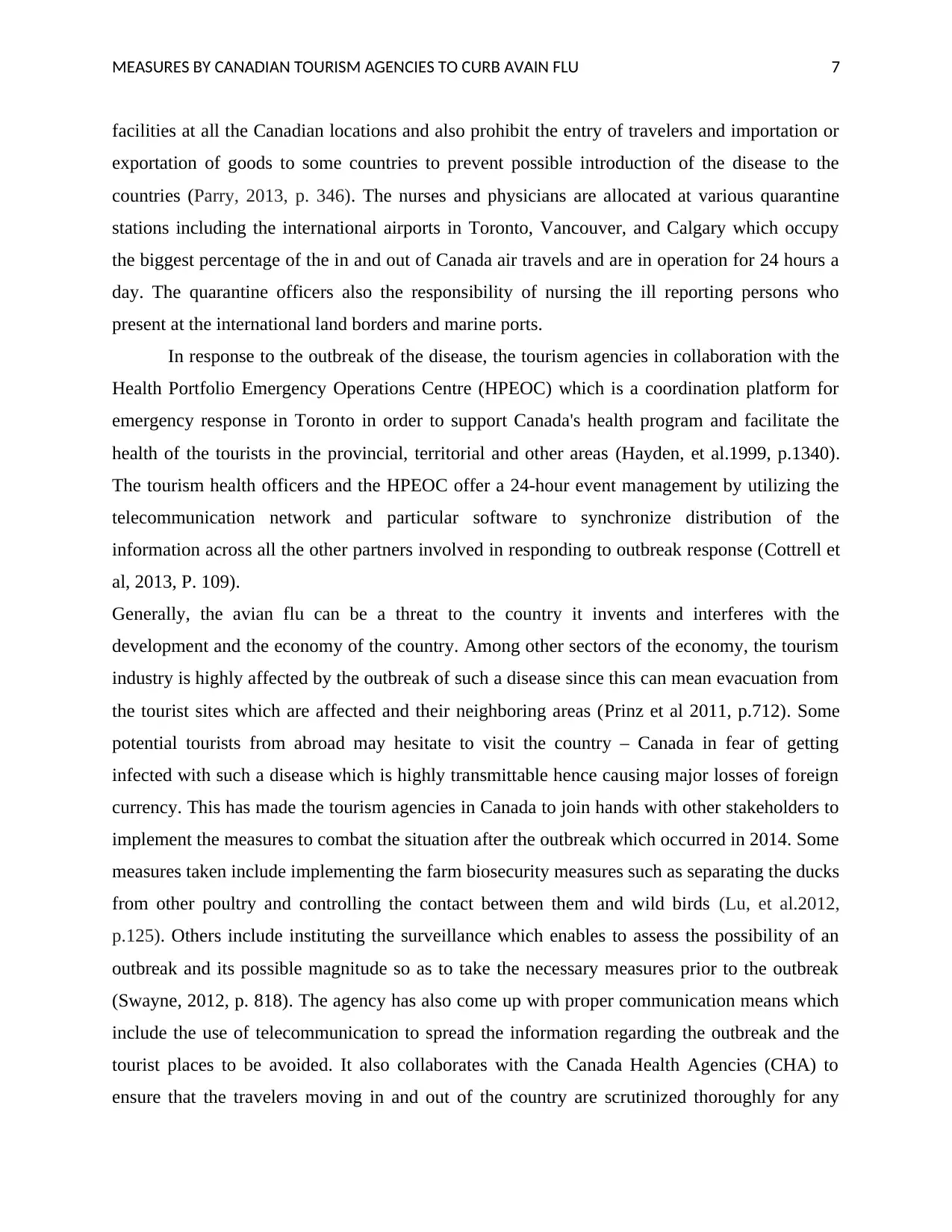
MEASURES BY CANADIAN TOURISM AGENCIES TO CURB AVAIN FLU 7
facilities at all the Canadian locations and also prohibit the entry of travelers and importation or
exportation of goods to some countries to prevent possible introduction of the disease to the
countries (Parry, 2013, p. 346). The nurses and physicians are allocated at various quarantine
stations including the international airports in Toronto, Vancouver, and Calgary which occupy
the biggest percentage of the in and out of Canada air travels and are in operation for 24 hours a
day. The quarantine officers also the responsibility of nursing the ill reporting persons who
present at the international land borders and marine ports.
In response to the outbreak of the disease, the tourism agencies in collaboration with the
Health Portfolio Emergency Operations Centre (HPEOC) which is a coordination platform for
emergency response in Toronto in order to support Canada's health program and facilitate the
health of the tourists in the provincial, territorial and other areas (Hayden, et al.1999, p.1340).
The tourism health officers and the HPEOC offer a 24-hour event management by utilizing the
telecommunication network and particular software to synchronize distribution of the
information across all the other partners involved in responding to outbreak response (Cottrell et
al, 2013, P. 109).
Generally, the avian flu can be a threat to the country it invents and interferes with the
development and the economy of the country. Among other sectors of the economy, the tourism
industry is highly affected by the outbreak of such a disease since this can mean evacuation from
the tourist sites which are affected and their neighboring areas (Prinz et al 2011, p.712). Some
potential tourists from abroad may hesitate to visit the country – Canada in fear of getting
infected with such a disease which is highly transmittable hence causing major losses of foreign
currency. This has made the tourism agencies in Canada to join hands with other stakeholders to
implement the measures to combat the situation after the outbreak which occurred in 2014. Some
measures taken include implementing the farm biosecurity measures such as separating the ducks
from other poultry and controlling the contact between them and wild birds (Lu, et al.2012,
p.125). Others include instituting the surveillance which enables to assess the possibility of an
outbreak and its possible magnitude so as to take the necessary measures prior to the outbreak
(Swayne, 2012, p. 818). The agency has also come up with proper communication means which
include the use of telecommunication to spread the information regarding the outbreak and the
tourist places to be avoided. It also collaborates with the Canada Health Agencies (CHA) to
ensure that the travelers moving in and out of the country are scrutinized thoroughly for any
facilities at all the Canadian locations and also prohibit the entry of travelers and importation or
exportation of goods to some countries to prevent possible introduction of the disease to the
countries (Parry, 2013, p. 346). The nurses and physicians are allocated at various quarantine
stations including the international airports in Toronto, Vancouver, and Calgary which occupy
the biggest percentage of the in and out of Canada air travels and are in operation for 24 hours a
day. The quarantine officers also the responsibility of nursing the ill reporting persons who
present at the international land borders and marine ports.
In response to the outbreak of the disease, the tourism agencies in collaboration with the
Health Portfolio Emergency Operations Centre (HPEOC) which is a coordination platform for
emergency response in Toronto in order to support Canada's health program and facilitate the
health of the tourists in the provincial, territorial and other areas (Hayden, et al.1999, p.1340).
The tourism health officers and the HPEOC offer a 24-hour event management by utilizing the
telecommunication network and particular software to synchronize distribution of the
information across all the other partners involved in responding to outbreak response (Cottrell et
al, 2013, P. 109).
Generally, the avian flu can be a threat to the country it invents and interferes with the
development and the economy of the country. Among other sectors of the economy, the tourism
industry is highly affected by the outbreak of such a disease since this can mean evacuation from
the tourist sites which are affected and their neighboring areas (Prinz et al 2011, p.712). Some
potential tourists from abroad may hesitate to visit the country – Canada in fear of getting
infected with such a disease which is highly transmittable hence causing major losses of foreign
currency. This has made the tourism agencies in Canada to join hands with other stakeholders to
implement the measures to combat the situation after the outbreak which occurred in 2014. Some
measures taken include implementing the farm biosecurity measures such as separating the ducks
from other poultry and controlling the contact between them and wild birds (Lu, et al.2012,
p.125). Others include instituting the surveillance which enables to assess the possibility of an
outbreak and its possible magnitude so as to take the necessary measures prior to the outbreak
(Swayne, 2012, p. 818). The agency has also come up with proper communication means which
include the use of telecommunication to spread the information regarding the outbreak and the
tourist places to be avoided. It also collaborates with the Canada Health Agencies (CHA) to
ensure that the travelers moving in and out of the country are scrutinized thoroughly for any
Paraphrase This Document
Need a fresh take? Get an instant paraphrase of this document with our AI Paraphraser
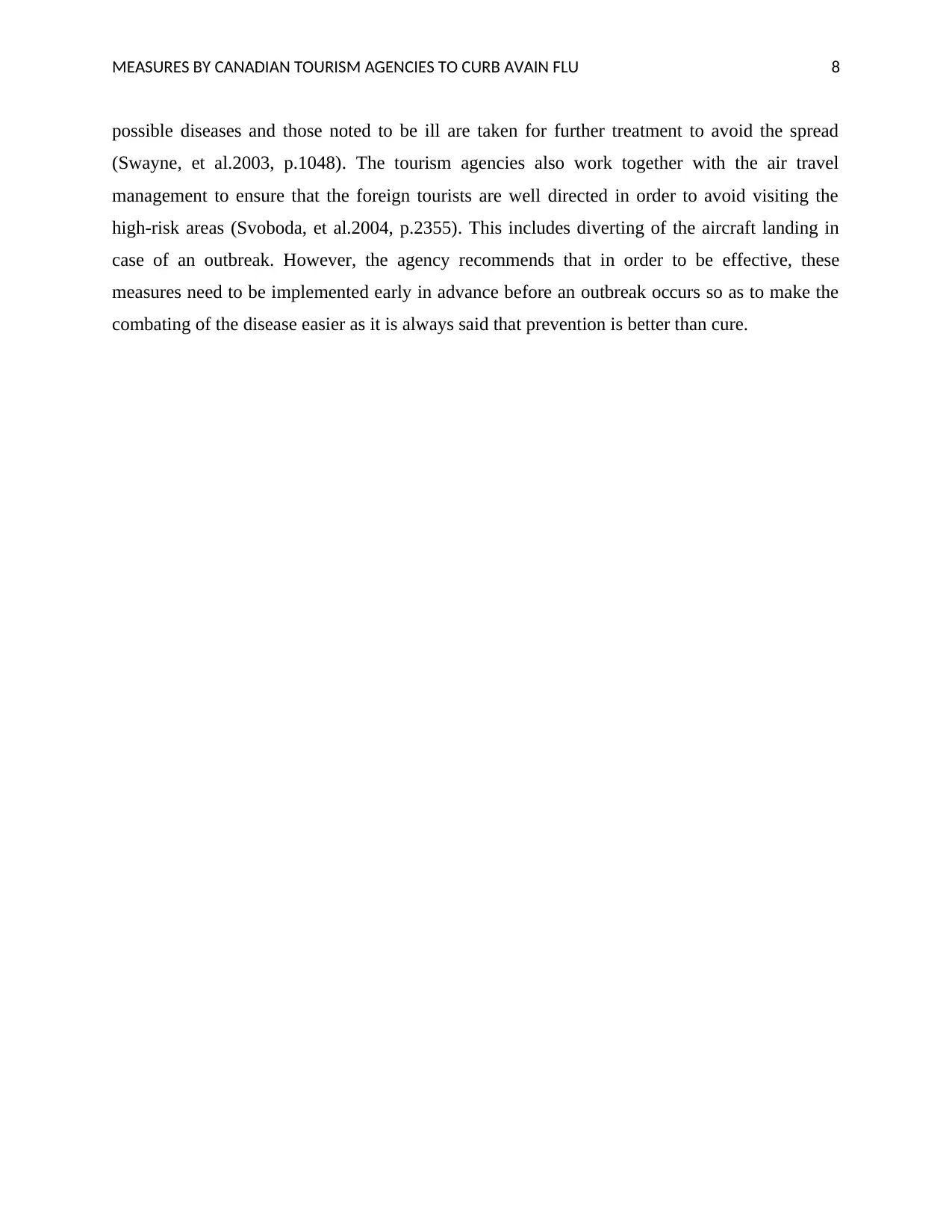
MEASURES BY CANADIAN TOURISM AGENCIES TO CURB AVAIN FLU 8
possible diseases and those noted to be ill are taken for further treatment to avoid the spread
(Swayne, et al.2003, p.1048). The tourism agencies also work together with the air travel
management to ensure that the foreign tourists are well directed in order to avoid visiting the
high-risk areas (Svoboda, et al.2004, p.2355). This includes diverting of the aircraft landing in
case of an outbreak. However, the agency recommends that in order to be effective, these
measures need to be implemented early in advance before an outbreak occurs so as to make the
combating of the disease easier as it is always said that prevention is better than cure.
possible diseases and those noted to be ill are taken for further treatment to avoid the spread
(Swayne, et al.2003, p.1048). The tourism agencies also work together with the air travel
management to ensure that the foreign tourists are well directed in order to avoid visiting the
high-risk areas (Svoboda, et al.2004, p.2355). This includes diverting of the aircraft landing in
case of an outbreak. However, the agency recommends that in order to be effective, these
measures need to be implemented early in advance before an outbreak occurs so as to make the
combating of the disease easier as it is always said that prevention is better than cure.
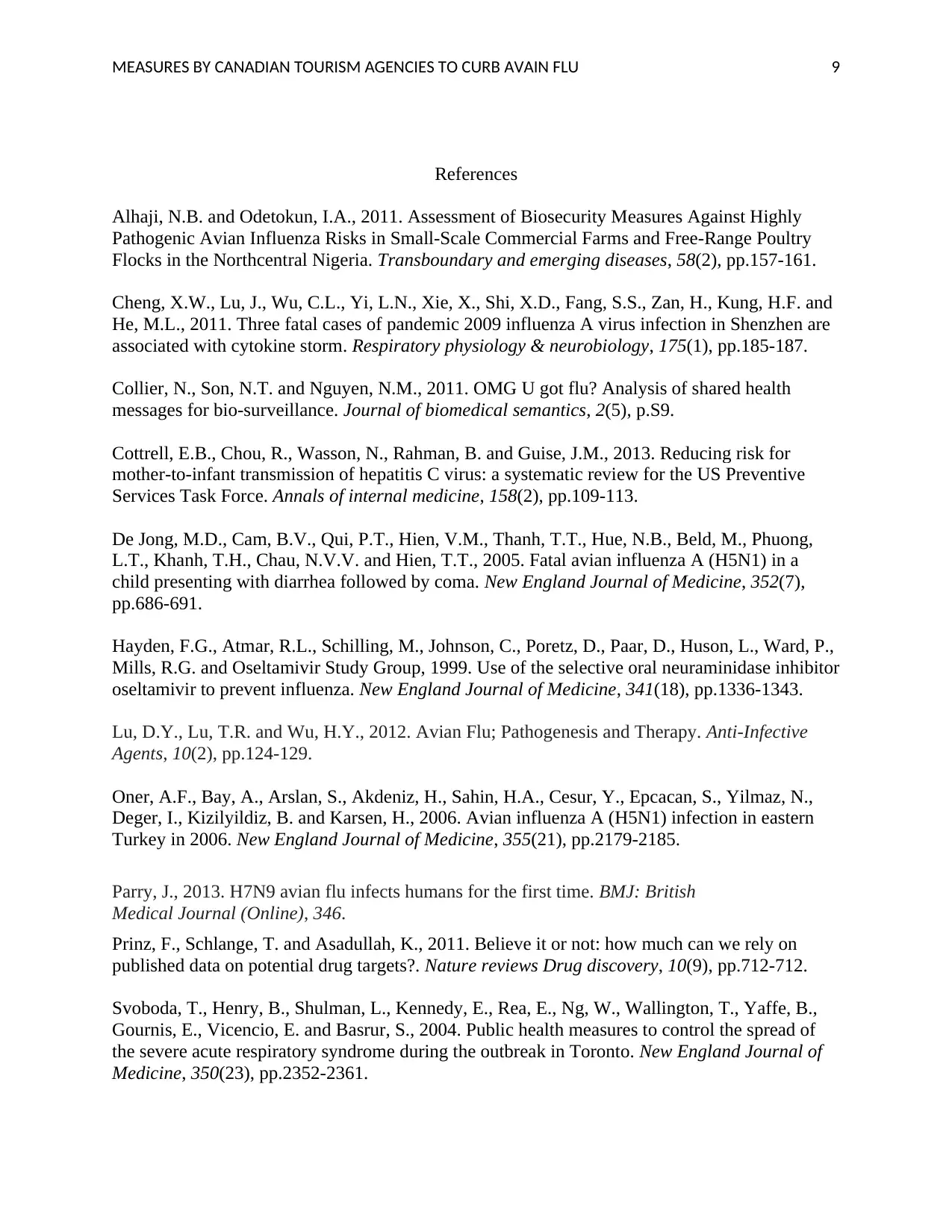
MEASURES BY CANADIAN TOURISM AGENCIES TO CURB AVAIN FLU 9
References
Alhaji, N.B. and Odetokun, I.A., 2011. Assessment of Biosecurity Measures Against Highly
Pathogenic Avian Influenza Risks in Small‐Scale Commercial Farms and Free‐Range Poultry
Flocks in the Northcentral Nigeria. Transboundary and emerging diseases, 58(2), pp.157-161.
Cheng, X.W., Lu, J., Wu, C.L., Yi, L.N., Xie, X., Shi, X.D., Fang, S.S., Zan, H., Kung, H.F. and
He, M.L., 2011. Three fatal cases of pandemic 2009 influenza A virus infection in Shenzhen are
associated with cytokine storm. Respiratory physiology & neurobiology, 175(1), pp.185-187.
Collier, N., Son, N.T. and Nguyen, N.M., 2011. OMG U got flu? Analysis of shared health
messages for bio-surveillance. Journal of biomedical semantics, 2(5), p.S9.
Cottrell, E.B., Chou, R., Wasson, N., Rahman, B. and Guise, J.M., 2013. Reducing risk for
mother-to-infant transmission of hepatitis C virus: a systematic review for the US Preventive
Services Task Force. Annals of internal medicine, 158(2), pp.109-113.
De Jong, M.D., Cam, B.V., Qui, P.T., Hien, V.M., Thanh, T.T., Hue, N.B., Beld, M., Phuong,
L.T., Khanh, T.H., Chau, N.V.V. and Hien, T.T., 2005. Fatal avian influenza A (H5N1) in a
child presenting with diarrhea followed by coma. New England Journal of Medicine, 352(7),
pp.686-691.
Hayden, F.G., Atmar, R.L., Schilling, M., Johnson, C., Poretz, D., Paar, D., Huson, L., Ward, P.,
Mills, R.G. and Oseltamivir Study Group, 1999. Use of the selective oral neuraminidase inhibitor
oseltamivir to prevent influenza. New England Journal of Medicine, 341(18), pp.1336-1343.
Lu, D.Y., Lu, T.R. and Wu, H.Y., 2012. Avian Flu; Pathogenesis and Therapy. Anti-Infective
Agents, 10(2), pp.124-129.
Oner, A.F., Bay, A., Arslan, S., Akdeniz, H., Sahin, H.A., Cesur, Y., Epcacan, S., Yilmaz, N.,
Deger, I., Kizilyildiz, B. and Karsen, H., 2006. Avian influenza A (H5N1) infection in eastern
Turkey in 2006. New England Journal of Medicine, 355(21), pp.2179-2185.
Parry, J., 2013. H7N9 avian flu infects humans for the first time. BMJ: British
Medical Journal (Online), 346.
Prinz, F., Schlange, T. and Asadullah, K., 2011. Believe it or not: how much can we rely on
published data on potential drug targets?. Nature reviews Drug discovery, 10(9), pp.712-712.
Svoboda, T., Henry, B., Shulman, L., Kennedy, E., Rea, E., Ng, W., Wallington, T., Yaffe, B.,
Gournis, E., Vicencio, E. and Basrur, S., 2004. Public health measures to control the spread of
the severe acute respiratory syndrome during the outbreak in Toronto. New England Journal of
Medicine, 350(23), pp.2352-2361.
References
Alhaji, N.B. and Odetokun, I.A., 2011. Assessment of Biosecurity Measures Against Highly
Pathogenic Avian Influenza Risks in Small‐Scale Commercial Farms and Free‐Range Poultry
Flocks in the Northcentral Nigeria. Transboundary and emerging diseases, 58(2), pp.157-161.
Cheng, X.W., Lu, J., Wu, C.L., Yi, L.N., Xie, X., Shi, X.D., Fang, S.S., Zan, H., Kung, H.F. and
He, M.L., 2011. Three fatal cases of pandemic 2009 influenza A virus infection in Shenzhen are
associated with cytokine storm. Respiratory physiology & neurobiology, 175(1), pp.185-187.
Collier, N., Son, N.T. and Nguyen, N.M., 2011. OMG U got flu? Analysis of shared health
messages for bio-surveillance. Journal of biomedical semantics, 2(5), p.S9.
Cottrell, E.B., Chou, R., Wasson, N., Rahman, B. and Guise, J.M., 2013. Reducing risk for
mother-to-infant transmission of hepatitis C virus: a systematic review for the US Preventive
Services Task Force. Annals of internal medicine, 158(2), pp.109-113.
De Jong, M.D., Cam, B.V., Qui, P.T., Hien, V.M., Thanh, T.T., Hue, N.B., Beld, M., Phuong,
L.T., Khanh, T.H., Chau, N.V.V. and Hien, T.T., 2005. Fatal avian influenza A (H5N1) in a
child presenting with diarrhea followed by coma. New England Journal of Medicine, 352(7),
pp.686-691.
Hayden, F.G., Atmar, R.L., Schilling, M., Johnson, C., Poretz, D., Paar, D., Huson, L., Ward, P.,
Mills, R.G. and Oseltamivir Study Group, 1999. Use of the selective oral neuraminidase inhibitor
oseltamivir to prevent influenza. New England Journal of Medicine, 341(18), pp.1336-1343.
Lu, D.Y., Lu, T.R. and Wu, H.Y., 2012. Avian Flu; Pathogenesis and Therapy. Anti-Infective
Agents, 10(2), pp.124-129.
Oner, A.F., Bay, A., Arslan, S., Akdeniz, H., Sahin, H.A., Cesur, Y., Epcacan, S., Yilmaz, N.,
Deger, I., Kizilyildiz, B. and Karsen, H., 2006. Avian influenza A (H5N1) infection in eastern
Turkey in 2006. New England Journal of Medicine, 355(21), pp.2179-2185.
Parry, J., 2013. H7N9 avian flu infects humans for the first time. BMJ: British
Medical Journal (Online), 346.
Prinz, F., Schlange, T. and Asadullah, K., 2011. Believe it or not: how much can we rely on
published data on potential drug targets?. Nature reviews Drug discovery, 10(9), pp.712-712.
Svoboda, T., Henry, B., Shulman, L., Kennedy, E., Rea, E., Ng, W., Wallington, T., Yaffe, B.,
Gournis, E., Vicencio, E. and Basrur, S., 2004. Public health measures to control the spread of
the severe acute respiratory syndrome during the outbreak in Toronto. New England Journal of
Medicine, 350(23), pp.2352-2361.
⊘ This is a preview!⊘
Do you want full access?
Subscribe today to unlock all pages.

Trusted by 1+ million students worldwide
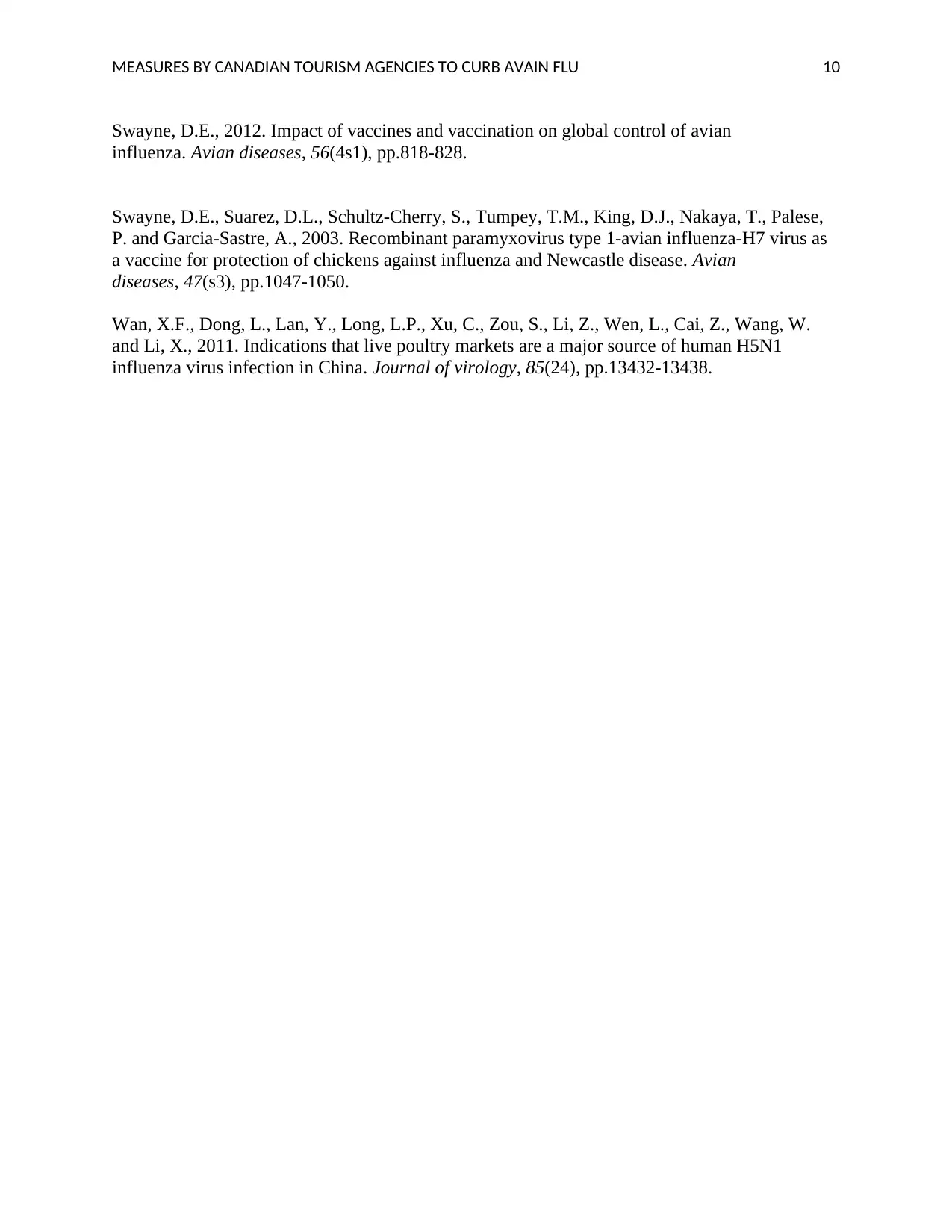
MEASURES BY CANADIAN TOURISM AGENCIES TO CURB AVAIN FLU 10
Swayne, D.E., 2012. Impact of vaccines and vaccination on global control of avian
influenza. Avian diseases, 56(4s1), pp.818-828.
Swayne, D.E., Suarez, D.L., Schultz-Cherry, S., Tumpey, T.M., King, D.J., Nakaya, T., Palese,
P. and Garcia-Sastre, A., 2003. Recombinant paramyxovirus type 1-avian influenza-H7 virus as
a vaccine for protection of chickens against influenza and Newcastle disease. Avian
diseases, 47(s3), pp.1047-1050.
Wan, X.F., Dong, L., Lan, Y., Long, L.P., Xu, C., Zou, S., Li, Z., Wen, L., Cai, Z., Wang, W.
and Li, X., 2011. Indications that live poultry markets are a major source of human H5N1
influenza virus infection in China. Journal of virology, 85(24), pp.13432-13438.
Swayne, D.E., 2012. Impact of vaccines and vaccination on global control of avian
influenza. Avian diseases, 56(4s1), pp.818-828.
Swayne, D.E., Suarez, D.L., Schultz-Cherry, S., Tumpey, T.M., King, D.J., Nakaya, T., Palese,
P. and Garcia-Sastre, A., 2003. Recombinant paramyxovirus type 1-avian influenza-H7 virus as
a vaccine for protection of chickens against influenza and Newcastle disease. Avian
diseases, 47(s3), pp.1047-1050.
Wan, X.F., Dong, L., Lan, Y., Long, L.P., Xu, C., Zou, S., Li, Z., Wen, L., Cai, Z., Wang, W.
and Li, X., 2011. Indications that live poultry markets are a major source of human H5N1
influenza virus infection in China. Journal of virology, 85(24), pp.13432-13438.
1 out of 10
Related Documents
Your All-in-One AI-Powered Toolkit for Academic Success.
+13062052269
info@desklib.com
Available 24*7 on WhatsApp / Email
![[object Object]](/_next/static/media/star-bottom.7253800d.svg)
Unlock your academic potential
Copyright © 2020–2025 A2Z Services. All Rights Reserved. Developed and managed by ZUCOL.


